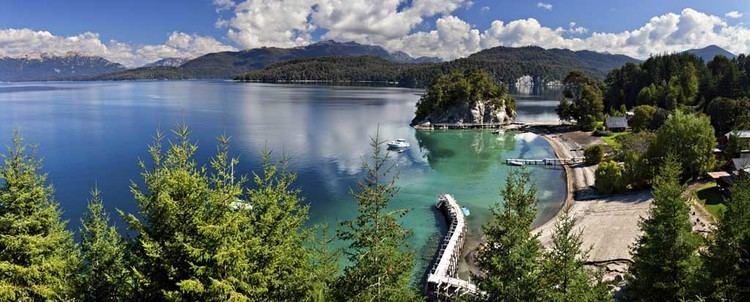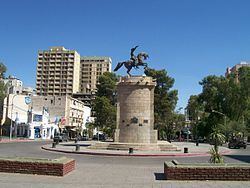Country Founded 1904 | Area 63 km2 | |
 | ||
Sold out concert in argentina neuqu n and buenos aires
Neuquén ([neuˈken]) is the capital city of the Argentine province of Neuquén, located in the east of the province, at the confluence of the Limay and Neuquén rivers. The city and the surrounding area have a population of more than 340,000, making it the largest city in Patagonia.
Contents
- Sold out concert in argentina neuqu n and buenos aires
- Map of Neuqun
- San mart n de los andes neuqu n argentina south america
- Economy
- Transport
- History
- Climate
- Museums
- Sport
- Sister cities
- References
Map of Neuquén
San mart n de los andes neuqu n argentina south america
Economy

Neuquén is both an important agricultural center, surrounded by fertile lands irrigated by the waters of the Limay and Neuquén rivers in an otherwise arid province, and a petrochemical industrial center that receives oil extracted from different points of the province. It belongs economically and geographically to the Alto Valle region that produces apples, pears, and other fruits.

With the discovery of the Vaca Muerta oil fields west of the city (3rd largest shale gas & oil reserves in the world), it has begun to experience a boom in real estate and construction. It is expected that over the next few years the city will experience unprecedented growth as it is the only significant city in the region (it has an airport, shopping centers, office space and institutions to become the center of the operations not only of the oil & gas companies, but also their suppliers)
Transport

National Route 22 divides the city into two halves.
The Presidente Perón Airport is eight kilometers (5.0 miles) away from the city and serves regular flights to Buenos Aires, San Carlos de Bariloche, Comodoro Rivadavia, Río Gallegos, Río Grande, Ushuaia, and San Martín de los Andes.
History
In 1885, the lands of what was at that time called Confluencia (i.e., "confluence," referring to the two rivers) were auctioned to a few people. Shortly after the Conquest of the Desert campaign conducted by the military over Patagonia, the Tehuelche and Pehuenche tribes that inhabited the province of Neuquén were either killed or pushed out of these lands.
Since there was no defined border with Chile, the Argentine government reached an agreement with the British-owned Buenos Aires Great Southern Railway company that was constructing a railway network, mainly in Buenos Aires Province, to build an extension to the town in exchange for lands, in order to populate it. In 1899, the railroad reached Cipolletti in Río Negro province, and three years later, after the construction of the bridge, arrived at Neuquén.
Neuquén was officially founded on September 12, 1904, and the capital of the territory was transferred from Chos Malal to the young town. The name "Neuquén" derives from the Mapudungun word nehuenken, meaning drafty, which the native people used in reference to this river.
By 1930, the town had only 5,000 inhabitants. In the 1960s, it acquired a new importance when oil deposits were found in the province by the state company YPF. The 1970s and 1980s saw massive demographic growth, accompanied by improvements such as the creation of the National University of Comahue in 1971.
Climate
Neuquén has an arid climate (Köppen BWk). Precipitation is low, averaging 200 millimetres (8 in) per year, which is fairly evenly distributed throughout the year. The mean annual temperature is between 14 to 15 °C (57 to 59 °F). During December and January, the mean temperature in these months is about 23 °C (73 °F) while in July, it reaches below 6 °C (43 °F). Being located far away from any major bodies of water, the thermal amplitude is high along with a large diurnal range, which indicates continental characteristics of the climate of the city.
Winds are moderately strong throughout the year, which favors evapotranspiration. Most of the wind comes from the west and the southwest, both of which occur 40-50% of the time. Summers tend to be windier than winters with average wind speeds ranging from a low of 8 km/h (5.0 mph) in July to a high of 16 km/h (9.9 mph) in December. Mean daily sunshine hours range from a high of 11 hours/day in January to a low of 3 hours/day in June.
The highest temperature recorded was 42.3 °C (108.1 °F) on January 21, 1980 while the lowest temperature recorded was −12.8 °C (9.0 °F) on June 13, 1961.
Museums
The Museo Nacional de Bellas Artes, designed by Mario Roberto Alvarez, opened in 2004. The museum showcases both national and international artists. The building consists of four halls which include both the temporary and the permanent collection, as well as an auditorium and theater.
Sport
Neuquén hosted the 2001 FIBA Americas Championship, where the city's basketball fans supported Argentina's national basketball team to win the gold medal. All games were played in the 8,000 seat Estadio Ruca Che. At the 1995 FIBA Americas Championship, Neuquén acted as co-host.
Since 2015 Neuquén hosts the F.I.M. Motocross World Championship: it's race track at Villa La Angostura was voted the best of the season in the two following seasons.
Sister cities
Neuquén is sister city, as designated by Sister Cities International with:
